欧洲50岁以上糖尿病患者的季节性流感疫苗接种覆盖率和流感疫苗接种的社会决定因素:分析2019-2020年和2021-2022年流感季节基于人群的SHARE数据
IF 4.5
3区 医学
Q2 IMMUNOLOGY
引用次数: 0
摘要
背景:患有慢性疾病的成年人的季节性流感疫苗接种覆盖率数据非常少。我们的目的是调查流感疫苗接种率,并探讨欧洲两个流感季节与疫苗接种相关的共同社会决定因素。方法:本横断面研究使用了2019-2020年和2021-2022年流感季节欧洲SHARE调查的数据。50岁以上的糖尿病患者被纳入研究,并计算了两个季节的加权流感疫苗接种率。使用多变量分析来检查两个季节中疫苗接种覆盖率与人口统计学、物理、社会和卫生保健因素之间的关系。结果:50岁以上糖尿病患者的加权季节性流感疫苗接种率在2021-2022季节(54%)显著高于2019-2020季节(46%)。在两个季节同时与流感疫苗接种呈正相关的因素包括年龄在65岁或以上;居住在西欧、北欧或南欧的;对基本医疗保险的满意度;有补充医疗保险;以及频繁的医疗咨询。结论:尽管有所增加,但欧洲流感疫苗接种的平均水平仍低于欧盟75%的目标。本研究通过提供50岁以上糖尿病患者流感疫苗接种覆盖率的信息,填补了ECDC的一个重要数据空白。这些发现强调了健全的社会和卫生保健系统在促进疫苗接种方面的关键作用。为提高疫苗接种率,ecdc资助的威尼斯网络应加强疫苗接种知识,通过加强地方规划和供资来解决社会经济差距问题,并与各利益攸关方合作制定区域战略。本文章由计算机程序翻译,如有差异,请以英文原文为准。
Seasonal influenza vaccination coverage and the social determinants of influenza vaccination among people over 50 with diabetes in Europe: Analyzing population-based SHARE data for the 2019–2020 and 2021–2022 influenza seasons
Background
Seasonal influenza vaccination coverage data for adults with chronic medical conditions are very scarce. We aimed to investigate the influenza vaccination rates and explore the common social determinants associated with vaccination in Europe across two influenza seasons.
Methods
This cross-sectional study used data from the European SHARE survey for the 2019–2020 and 2021–2022 influenza seasons. Participants over 50 diagnosed with diabetes were included, and weighted influenza vaccination rates for both seasons were calculated. Multivariable analyses were used to examine the relationships between vaccination coverage and demographic, physical, social, and healthcare factors over the two seasons.
Results
The weighted seasonal influenza vaccination coverage rate was significantly higher in the 2021–2022 season (54 %) than in the 2019–2020 season (46 %) among people over 50 with diabetes. Factors simultaneously and positively associated with influenza vaccination in both seasons included being aged 65 or older; residing in Western, Northern, or Southern Europe; satisfaction with basic health insurance; having supplementary health insurance; and frequent medical consultations.
Conclusions
Despite the increase, the average European influenza vaccination level remains below the EU target of 75 %. This study fills an important data gap for the ECDC by providing information on influenza vaccination coverage rates among people over 50 with diabetes. The findings highlight the crucial role of a robust social and healthcare system in promoting vaccination. To improve vaccination rates, the ECDC-funded VENICE network should enhance vaccination knowledge, address socioeconomic disparities by strengthening local programs and funding, and collaborate with various stakeholders to develop regional strategies.
求助全文
通过发布文献求助,成功后即可免费获取论文全文。
去求助
来源期刊

Vaccine
医学-免疫学
CiteScore
8.70
自引率
5.50%
发文量
992
审稿时长
131 days
期刊介绍:
Vaccine is unique in publishing the highest quality science across all disciplines relevant to the field of vaccinology - all original article submissions across basic and clinical research, vaccine manufacturing, history, public policy, behavioral science and ethics, social sciences, safety, and many other related areas are welcomed. The submission categories as given in the Guide for Authors indicate where we receive the most papers. Papers outside these major areas are also welcome and authors are encouraged to contact us with specific questions.
 求助内容:
求助内容: 应助结果提醒方式:
应助结果提醒方式:


